The Cities of Tomorrow
Continuing the theme of the future of humanity, this week we take a look at what we can expect from our towns and cities in the years to come. Will we be living in wooden skyscrapers, amongst crime fighting lampposts or have our own personalised pollution sensors? Plus, in the news, invasive shellfish, the amphibian version of Ebola, making the mind young again, why new brain cells are essential for learning, and advice to brush your teeth to boost your physical fitness...
In this episode
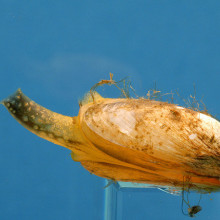
00:54 - Invading alien species
Invading alien species
with David Aldridge, University of Cambridge
As international trade increases particularly by sea, we're seeing more 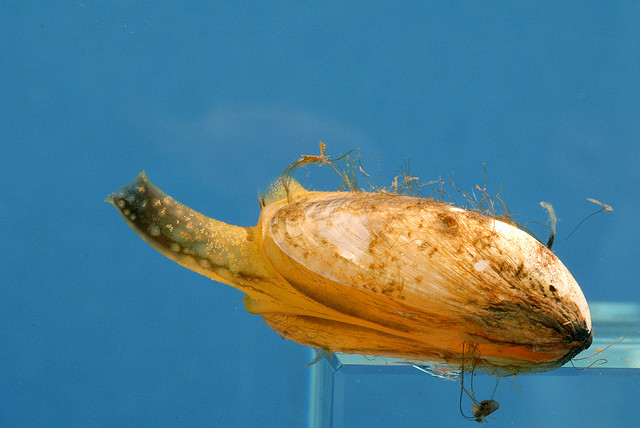 stowaways, but not of the human variety. Scientists are reporting that animals and plants are hitching rides around the world on boats and even on fishing tackle and then setting up home in other countries where, with nothing to eat them, they can become dangerously invasive.
stowaways, but not of the human variety. Scientists are reporting that animals and plants are hitching rides around the world on boats and even on fishing tackle and then setting up home in other countries where, with nothing to eat them, they can become dangerously invasive.
Invasive species specialist David Aldridge from the University of Cambridge showed Ginny Smith one of the species creating chaos in British waters...
David - It's just starting to create chaos. This is something called the quagga mussel. And it's the species we least wanted to arrive in the UK out of anything.
Ginny - So, you got a little tube full of them here and they're tiny. They look a bit like the mussels you might expect with your chips, but they're tiny. Do they stay that small?
David - Yeah, don't be fooled by their small size. They pack quite a punch - these guys. They are small at the moment because they've just arrived. They're about a centimetre at the moment here, but they grow to maybe 2 or 3 centimetres. And the problem really comes from the huge abundance that they can occur at. They're a real problem because as you say, they're like the marine mussels that we eat. These are freshwater species, but they have a byssus thread and they can attach one on top of the other and form very thick crusts, about 15 centimetres. And that causes a huge environmental problem and also, a huge economic problem.
Ginny - And what kind of problems are these crusts of mussels causing?
David - Directly, what they can do is attach to any hard surface and that includes our native freshwater mussels such as in vulnerable species called the depressed river mussel. It smothers them and kills them.
Ginny - I can see why it might be depressed.
David - Yes, they're going to be even more depressed very soon. Also, a single quagga mussel of about 2 centimetres could filter 2 litres of water a day and they change the nature of the water that they live in so they can push some systems towards a dominance of cyanobacteria - blue-green algae, which is toxic - problems for human drinking, for pets that might go in the water. But also, in some systems, they can drive the water much clearer. The light penetrates more deeply and you get more bottom-rooting planting and those plants were often used as weeds which create flood risk, angling problems, navigation problems.
Ginny - Amazing that something so small can cause so many different issues. Where are they coming from?
David - Well, these are really interesting because they're native to eastern Europe from the Ponto-Caspian regions, so the Black Sea, the Caspian Sea. And the whole of western Europe is being invaded by these species as a result of canal construction which is linked to a lot of the major rivers together. What we're finding is that as they arrive into the UK that actually, these species are interacting with each other in a positive way. And so, the arrival of one invader from this region is facilitating, it's making it easier for the other invaders to be a problem.
Ginny - Why do they cause so much trouble when they're over here and not when they're in their sort of original habitat?
David - Well, what tends to happen is that they often arrive and they don't have natural predators and enemies and their native range has been lots of co-evolution. And so, if you like, the system is in a bit of stasis. Things are settled down. Often, when they arrive in new areas, they might've escaped from their predators, or their diseases and so, they can proliferate very, very quickly. And so, these huge abundances drive massive ecological change.
Ginny - Is this just the case of things coming in or are there any invaders going out from England to other places?
David - Well obviously, invasive species are not just a special thing to the UK. It's something which happens around the world. And we're not just importers of non-native species - we're exporters as well. A good case is the shore crab which is quite common in British coasts. It's what children like to go and catch at the harbour sides. That species has become a real pest in North America.
Ginny - So, what can we do when we have these species coming in from other places and there are just aren't enough predators to eat them. Is there anything we can do to prevent them from taking over and damaging native species?
David - In the UK, we're in a very privilege position in that, we have control over our own waterways. If you're in mainland Europe then your water can come through 7 different countries. So, we do have the opportunities to try and control what actually comes into our freshwaters. And that involves us understanding the vectors and pathways of these pests. But then it comes down to policy. On a more practical level, we can manage biosecurity through the transports of freshwater invaders from one river to another. And that involves engaging with the public to encourage them to check their equipment, their fishing gear, their waders, their boats - clean them down, dry them before they move them from one water body to another. There are some emerging tools. We have a product which can kill these quagga mussels called the biobullet which has been successfully used against its slightly less naughty cousin, the zebra mussel in the UK. And the way the biobullet works is that it carries a salt which is toxic to the mussels which is encapsulated in a tasty little particle which is just the right size and shape for the mussels to filter out the water, and they take out this poison pill, and swallow it immediediatly and it kills them. And anything which they haven't eaten degrades to harmless concentrations very quickly. So its a very targeted solution which doesn't impact on humans, doesn't impact on other widlife.
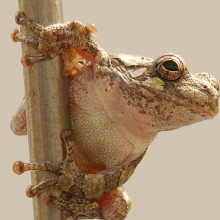
06:29 - Ebola-like virus wipes out amphibians
Ebola-like virus wipes out amphibians
with Stephen Price, University College London
Recently, frogs, toads and newts in the Spanish National Park Picos de Europa have been dying in unprecedented numbers from a horrible disease which 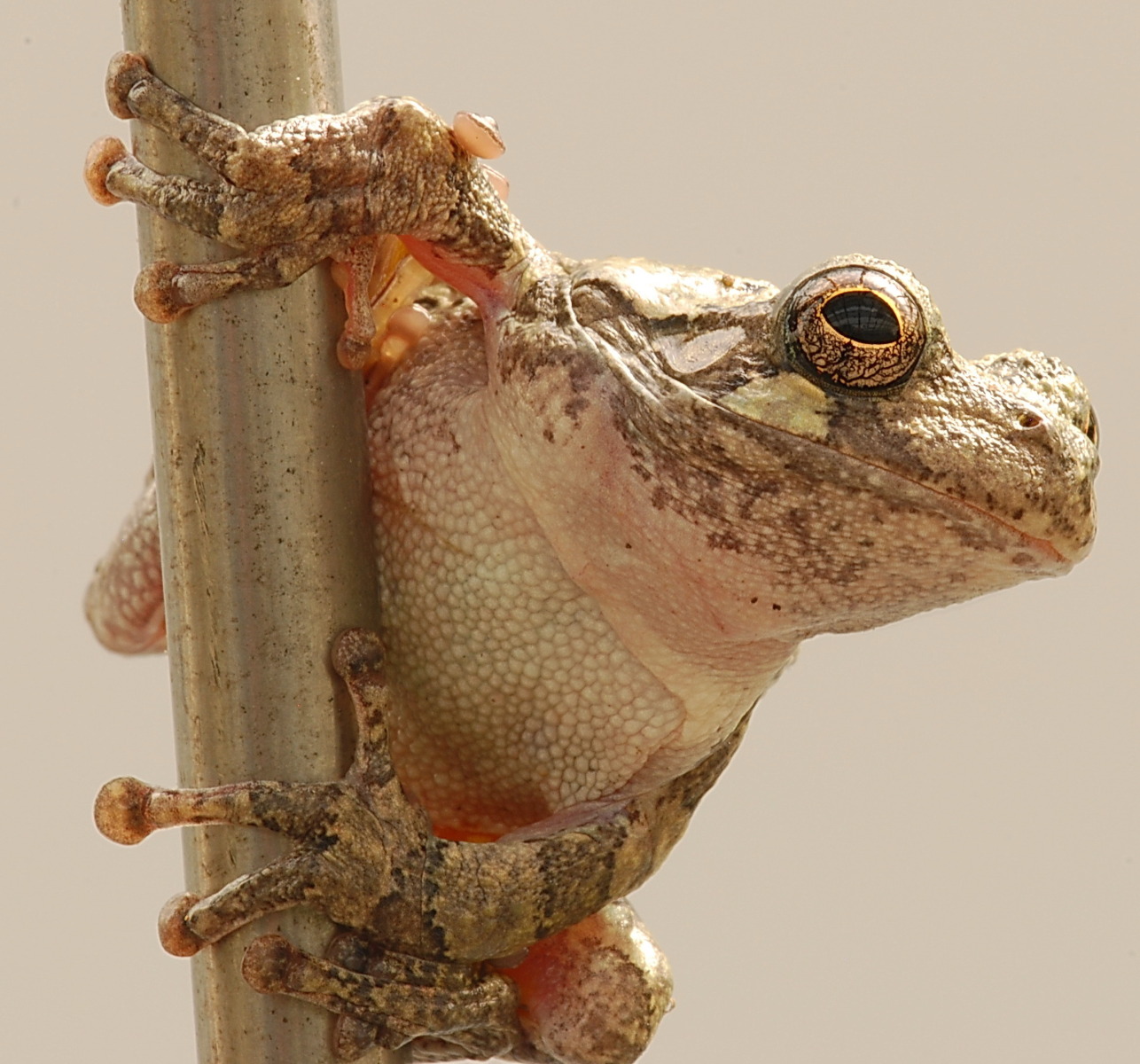 makes them bleed internally and which can only be described as frog Ebola.
makes them bleed internally and which can only be described as frog Ebola.
At the heart of this illness are agents called ranaviruses. These usually infect only amphibians but, unlike previous ranaviruses infections which have targeted one species, these new viruses are indiscriminately killing all kinds of amphibians and even reptiles that prey on the infected frogs and toads. Stephen Price from University College London explained to Kat Arney what had been going on...
Stephen - In 2005, the first observed mass mortality events were noted by rangers in the park. Severe disease across the entire amphibian community, so systemic haemorrhaging in all six common species of amphibian which are found in the National Park. The virus seems to affect most of the major tissues, also systemic haemorrhaging which effectively means bleeding from everywhere. And so, the amphibians can vomit blood and it can come out at both ends.
Kat - In this paper, what exactly were you looking at and what did you find?
Stephen - First question was, what's causing these infections? We found a fairly novel lineage of ranavirus which seems to have pre-exisiting capacity to infect all amphibian species present in the Picos de Europa. Also, we report on a snake which have been feeding on the amphibians and also died.
Kat - What does your research tell us about where these viruses might have come from?
Stephen - It's a tough question to work out the origins of these viruses at the moment, but the fact that these viruses are quite closely related to some Chinese viruses says that there's a real long distance international component to virus movement.
Kat - Frogs don't tend to move internationally. So, what do you think might be spreading this virus?
Stephen - We've seen almost simultaneous emergence at multiple sites in the Picos de Europa which is separated by many miles of rugged mountainous landscape. And so, that picture like you say is not consistent with a picture of amphibian dispersal moving this far around. You need to factor in something else and when you consider the pattern of relatedness of the virus in a global context, and other things that we know about ranavirus translocations globally. So, the presence of ranaviruses in traded and farmed amphibians, it suggests that there's an important role for humans in bringing these viruses into that region.
Kat - This sounds pretty bad news for amphibian populations if there's this virus spreading incredibly quickly across the globe, possibly moved by humans and it's causing a destruction of lots of different species. What can we do about it?
Stephen - It's a fairly grave situation, a really serious picture for amphibians. So, it's difficult to know how to tackle infections at wild ponds once they're established, other than removing all the animals that are infected from the site, which is a really tough ask and probably wouldn't be very popular anyway. So, I think the best way forward that I can see and that I can impact on is to try and get a better understanding of how these viruses are moving both globally and locally. And so, that's definitely something that I'll be looking to pursue with my research.

10:18 - Teaching old dogs new tricks
Teaching old dogs new tricks
with Carla Schatz, Stanford University
Scientists have discovered a substance in the nervous system which, if removed or its actions are blocked, can make the mind learn things like it did when we were first born. But there might be a downside - you might forget things you already knew more easily too! Stanford University  brain scientist Carla Shatz explained to Chris Smith how this discovery could help teach new tricks to old dogs, or even mice...
brain scientist Carla Shatz explained to Chris Smith how this discovery could help teach new tricks to old dogs, or even mice...
Carla - Why is it that kids have brains that seem to be able to learn like sponges? In particular, I've always wondered why it is, it's so easy to learn several languages as a child. But as I try to learn French as an adult, it is impossibly difficult for me. And so, we have been studying what are known as early critical periods of development and trying to understand its mechanisms because the language problem is a great example of a critical period for learning language. It's easy to learn in the child, but hard to learn in the adult.
Chris - So, would you say then that it's not just language, that this is a phenomenon generalisable to the way the entire nervous system works? It's not just language. It could apply to how your visual system processes what you see, how your ears process what you hear and so on.
Carla - Yes. This is definitely a general problem and it's in fact known that for example, the visual system has a similar critical period because it turns out, we have two eyes and we only have one view of the world. During a critical period of postnatal development, the brain learns how to combine the separate images from the two eyes into one single seamless binocular view of the world. And this has to happen with normal vision through both eyes during this early developmental critical period which in kids is up until the age of around 6 or so. If it doesn't then if an eye for example is weak, kind of a lazy eye or maybe it had a congenital cataract, and if that's not corrected during the critical period, then the vision through that eye is extremely diminished and possibly even, there's blindness. On the other hand, you know perfectly well that if your grandmother gets a cataract as an adult, having normal vision throughout her life, even if the cataract isn't corrected for a number of years, once it is, she can see perfectly well again.
Chris - Why do you think that the brain has evolved to be like a sponge when we're little, but extremely fixed and rigid as you get older? Is that to stop me having to go to medical school again?
Carla - The answer I think is really that when we're young, in terms of evolution, we almost certainly have to learn rapidly. We have to learn a number of lessons extremely fast. But on the other hand, if we have that same kind of rapid learning that allows for connections to kind of be loosened the way they are when we're young, if we have that when we're old we might lose things. And as you say, wouldn't it be awful to have to go back to school again? I couldn't imagine it.
Chris - Do you have any insights into what is going on biochemically in the brain to mean that those connections are much more fluid when we're little and we learn very quickly, but as we get older then they do become more fixed and it's much harder to change behaviour?
Carla - Well, this is part of the discovery that we've made because we've been trying to learn what are the underlying molecules that are mediating this kind of early flexibility, but later perhaps slightly more rigidity. Obviously, we're not totally rigid because we can still learn as adults. And we discovered molecules that appear to be really important for pruning away of connections in the brain. And these molecules are present in the adult brain too. So, there's some pruning going on even in the adult, but it is also known that for every connection that's pruned, there are connections that are added. So, there's a kind of stable state. What we discovered is that if we block the function of these molecules in the adult brain, then it becomes a more youthful brain in a sense that more connections can be made and fewer are removed.
Chris - What are the molecules?
Carla - In the mouse, there's a receptor which we call Pure B. What's really surprising is that these molecules, these receptors were only thought to have roles in the immune system. But a number of years ago, we discovered Pure B in the mouse nervous system in the brain and actually in neurons.
Chris - Do you know what chemical it is that binds on to this receptor to activate it?
Carla - Yes, we do and this is also surprising because these chemicals are the same ones that are known to bind on in the immune system. So again, the whole system seems to be used both in the brain and in the immune system.
Chris - Can we now go forward saying, "Right. Now, we're going to be able to turn university of the third age subscribers into undergraduates again and learn like an 18-year-old"?
Carla - I got really excited about this idea when we first made the discovery and then sort of reason took over and I realised that, "Gee! Let's say we had a pill that you could take to do that which will be cool." But would it be because maybe it would actually destabilise a lot of the learning that's happened. And so, for every new thing we learn, maybe we would actually again, forget and have to go back to med school because it might be that the pill will not only allow us to make new connections and learn new things, but also, might lose some of our old connections.

16:49 - Forgetting how to learn
Forgetting how to learn
with Bill Richardson, University College London
When the brain learns it makes new cells called oligodendrocytes. It's their job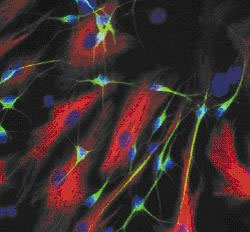 to wrap around and support nerve fibres. If this process is blocked then learning can't take place as Bill Richardson explained to Chris Smith...
to wrap around and support nerve fibres. If this process is blocked then learning can't take place as Bill Richardson explained to Chris Smith...
Bill - What many neuroscientists have been solving is, how does the brain work, how do we learn and remember new things - new ways of moving, new practical skills? Something must change in your head when you learn something new, but no one has the faintest idea of what that is. Previously, it's been thought that learning was really a neuron thing. Neurons are the cells in your brain that communicate with one another by electrical signals. They send signals down long threads like wires called axons. But we recently found that another type of cell in the brain called oligodendrocytes. Its role is to insulate the wires or the axons of the neurons. They wrap themselves around in a kind of like rolling up a sleeping bag around a snooker cue. Now, we've discovered that these cells continue to be formed throughout adult life in mice. There is evidence also from MRI (magnetic resonance imaging) in humans that white matter which is part of the brain where these axons are all wound up. Those continue to grow throughout human life. guessing that that might be something to do with oligodendrocytes. We decided to test the idea directly that new oligodendrocytes are required for learning complex skills in mice. So, we first of all setup a test of learning ability in mice and mice loved to run on wheels and mice will run the equivalent of 5 to 7 km every night. What we did was, we removed rungs in a quasi-random pattern to create a more difficult task.
Chris - These would be the rungs in the wheel. So the mice, instead of just having to repeatedly move their feet forward by a known distance each time, they're having to second guess whether a rung is missing and adapt their stride accordingly.
Bill - That's absolutely correct. They have severe difficulties and when you look at them and move these, you're amazed that they actually persevere. But they do, they persevere and within a week, they can run as fast in those wheels as they could do on a normal uncomplicated wheel.
Chris - And this is by adapting their running technique. They're having to learn to move at a new way to compensate for the missing rungs.
Bill - That's right.
Chris - So, having engineered this pretty tricky motor learning task for these mice, how do you then tell whether these oligodendrocytes are involved?
Bill - Well, the idea is very simple. If you prevent new oligodendrocytes from forming then they should not be able to learn. We devised a genetic trick that allow the mice to develop normally to adulthood and then inject a drug to flick a genetic switch that would delete a gene required for new oligodendrocytes forming without affecting oligodendrocytes formed previously.
Chris - So, if your theory is correct and learning involves these oligodendrocytes making new contacts and so on, if you block the production of new oligodendrocytes in the brain, you should impair learning. Is that what you found?
Bill - That's what we found. The mice were seriously impaired to learn to run its feet on this complex wheel.
Chris - So, these oligodendrocytes that are being impacted by deleting this gene, they're coming from some kind of stem cell in the brain that produces new oligodendrocytes and you stop that happening so you therefore impair future learning but you don't alter established learning, things you know already.
Bill - Exactly. These new oligodendrocytes are formed by precursor cells, kind of like stem cells and these cells are very numerous in our brains. They're about 5% of all of our brain cells and it was initially a mystery as to why we should have so many of these precursor cells in our brains during adulthood. They are there apparently to provide new oligodendrocytes for learning new practical tasks and maybe they're involved in other types of learning like arithmetic learning and that kind of thing.
Chris - So, what do you think the implications of what you found are?
Bill - What we've uncovered is an additional refinement which is nevertheless essential and that provides us with a new target perhaps that would allow us in time to be able to tweak learning, maybe enhance learning or since it's difficult to forget things. Once you've learned to ride a bicycle, you never forget. It's also very difficult to forget bad habits. So, maybe if we could manipulate oligodendrocytes, we could more easily forget bad habits and relearn them in a better way.

22:00 - Bad teeth hurt your sporting chances...
Bad teeth hurt your sporting chances...
with Ian Needleman, University College London
Is brushing your teeth part of your exercise regime? Well if not, it probably  should be, because poor dental health can dent your athletic performance according to new research. Consumption of sugar-filled energy drinks and gels could lead to tooth decay and immunosupression during intensive bouts of physical sessions could make you more susceptible to oral diseases.
should be, because poor dental health can dent your athletic performance according to new research. Consumption of sugar-filled energy drinks and gels could lead to tooth decay and immunosupression during intensive bouts of physical sessions could make you more susceptible to oral diseases.
Kat Arney spoke to Ian Needleman from University College London to brush up on the science behind this...
Ian - We carried out a large research study at the London Olympics, London 2012 and we included about 300 athletes and we found perhaps surprisingly that their oral health was very poor. They had high levels of tooth decay, erosion of the teeth and gum disease, and a level which would be similar to a disadvantaged population.
Kat - This seems strange to me because you think of athletes maybe as more healthy than the general population but you're saying that their teeth and their gums are really not in a great shape.
Ian - Yeah, that's right. So, they may appear more healthy, but their mouths were actually appear worse than the general population. Perhaps even more surprising to a lot of people is, we asked athletes to rate the impact of their oral health on their training and performance. And about 20%, about 1 in 5, felt that it was affecting their training and performance. That's 20% at that level of an elite athlete who have a goal of - they ended up 4 years of achieving a really fantastic goal is quite a striking finding.
Kat - So, it's nothing to do with whether their ankles are giving in or anything. It could just be their teeth affecting their performance.
Ian - Well, that's right. I think that when we're talking about elite athletes, small effects can make the difference between a gold medal or no medal at all. Oral health is likely to be one of many things related to health and psychology which will have an effect on athletes. We also know, we've heard from a lot of team doctors and from coaches and physios, there are - in addition to these sort of small effects - a few athletes get catastrophic problems. So, acute infections which then take them out of an event, out of training for a long period of time, but those kind of acute things, those catastrophic events don't happen to too many people.
Kat - Is this across the board no matter where in the world the athletes come from? Obviously, the Olympics is an international event.
Ian - Yeah, that's right. certainly, from our data, it does seem to be widespread. We've also looked - we've carried out something called a systematic review which looks at all of the evidence that's out there in the research literature. And again, the findings are very similar, whether it's a developing country or whether it was a developed country, whether it's a country which has a fantastic provision of dental care or whether there isn't much available.
Kat - So, what's causing this because when I think about athletes, I think about people who are eating healthy diets and all this kind of thing and when I think about tooth decay, I think about people who are eating lots of sweeties and not brushing their teeth properly? What's causing these problems in athletes?
Ian - Well, we think there are a number of things and nutrition, certainly you're right to pick on that. That seems an obvious candidate and it certainly seems to be one of the factors. So, nutrition could be high carb diets, it could energy supplements and suddenly, tooth decay is one of the factors which seems to be a problem in athletes. It's what we know about tooth decay and sugars is its frequency. Of course, athletes will often take quite a high frequency of carbohydrates.
Kat - This could be things like energy drinks or gels I guess.
Ian - It could be those energy supplements, but it could also be their diet. So, I think it's important to look more sort of holistically at the nutrition. The energy drinks will be part of that and the gels, but it's not just that. it's the diet generally.
Kat - So, as well as things that they might be eating - so maybe sugary drinks or something like that - are there any other things that may be impacting their dental health?
Ian - So, in athletes who breathe hard, what's going to happen is that their saliva will be dried up and saliva is very protective. It's got natural antibacterial substances and antibodies. So, losing that protection puts people at greater risk of oral diseases. And also, what we know is some really good evidence that during periods of really intensive training, it will have an effect of immune suppression. So, your immunity, your immune response protection against the bacteria, will be suppressed for short periods of time. So again, it could increase your risk of oral diseases.
Kat - What can we do to address this because obviously, if this is impacting on athletes' health and their performance, and their well-being, surely, it will be a good thing to try and improve this?
Ian - It's really important for all of us, but particularly for elite athletes to be thinking about nutrition and diet. And what we're saying is that if you need energy supplements in the form of drinks or gels for performance or a training, then use them. But there are times when you don't need them, for instance when you're rehydrating, water is good, or are they hypotonic drinks which have very low levels of added sugars. So, just train smart essentially.

27:08 - From seeds to skyscrapers
From seeds to skyscrapers
with Michael Ramage, University of Cambridge
As more and more people move to cities every day, where are they all going to live? One of the main options is to build up. But, with steel prices climbing,  engineers are looking to another resource which literally grows on trees. Wood isn't strong or stiff enough to be used in construction past a certain height. But a team at Cambridge University are working to try to change the molecular properties of wood to turn it into something suitable for building skyscrapers. Georgia Mills spoke to Michael Ramage who's heading up the project...
engineers are looking to another resource which literally grows on trees. Wood isn't strong or stiff enough to be used in construction past a certain height. But a team at Cambridge University are working to try to change the molecular properties of wood to turn it into something suitable for building skyscrapers. Georgia Mills spoke to Michael Ramage who's heading up the project...
Michael - We're working on a project using natural materials, in particular from plants to make large buildings. The very short story is going from seeds to skyscrapers. We are hoping to be able to modify wood in such a way that it will be strong enough to last a lifetime and work at the forces that you would have in a large skyscraper.
Georgia - Why change it from steel and concrete? Why do we need to have wooden skyscrapers?
Michael - Well, we think wood is a good alternative to steel and concrete for a number of reasons. It's a carbon sink. The wood absorbs carbon dioxide while it grows and stores it as the structural material of the wood itself. There is a limited amount of steel in the world. So, we actually need to find something to replace it. there is a growing amount of wood in the world and these are crop forests. They're not virgin forests. In general, people feel very good about wood. They feel comfortable in wood, with wood surrounding them. So, we think it will make for better buildings in the long run.
Georgia - So, why don't we have wooden skyscrapers already?
Michael - We don't have wooden skyscrapers primarily because steel and concrete are pretty good materials for making skyscrapers. So, we haven't had the need to figure out how to make them with wood. Wood has worked extremely well on a domestic scale. So, people have been doing that very happily for hundreds of years. But we're reaching a point where we need to innovate more with wood and do things that it hasn't done before.
Georgia - What would happen if you try to build a skyscraper out of wood now?
Michael - What the tallest skyscraper out of wood at the moment is 10 storeys tall. We've designed a 70-storey tall building, but we know that it will collapse. Part of the reason we designed it is to figure out how and why it collapses so we have a better understanding of what properties wood needs to have in order to make it possible to build at those scales. Wood is very good in tension and compression so when you pull on it or push on it, along the length of the wood. But if you push across the length - so imagine squeezing the trunk of a tree. It's not very strong. So, in technical terms, we call that perpendicular to the grain. So, that needs to be made stronger. Wood is very flexible so we need to make it stiffer. If you think about a tree in a storm, most of the time, they don't fall over but they bend a lot in the wind. Buildings can't do that because people would get sick.
Georgia - So wood, we just find from trees. How on earth are you going to change its properties?
Michael - We're going to look at two ways of changing their properties. We'll look at a biochemical perspective and a chemical perspective. So, the biochemical approach will be looking at the cells themselves. Are there things from what we know about plants and plant science that we can genetically encourage the trees to have stronger cells. Chemically, we'll be looking at the same cells and see if there are things we can do chemically to make the cell wall stronger for example or the connection between various cells stronger. If we can do that, we can make the microproperties of the wood better and we would be looking for a translation to the large scale properties. We're looking at every single aspect of the science and the engineering at the same time. so, we're looking at the micro scale of the cells. At the same time, we're looking at the mega scale design of buildings. We end up with some very interesting conversations between microbiologists, and biochemists and structural engineers because at the outset, we speak of different language, but we all work on the same material. Those conversations we think are a new approach to thinking about the material.
Georgia - I know in some people's minds, wood is definitely linked with fire. Would these buildings pose an extra risk in terms of flammability?
Michael - That's a perception that we will certainly need to deal with. These very large wooden buildings are not flammable at all. Anyone who's built a campfire knows that we have to use small kindling to get it started and the big logs won't burn without any help. So, big wooden buildings never catch fire. They char, but we know how much they char. It's well-documented so we just make the structure a little bit larger and then the charred wood is actually an insulator for the structural material inside. There are some examples where wood has outperformed steel in very big fires.
Georgia - How long do you expect it to be before we see our first wooden skyscraper?
Michael - We would love to see one in the next 5 to 10 years. There are designs from practices around the world for 20, 30 storey buildings in timber. No one has completed one yet, but certainly, in the next 5 years, I think it would be a possibility.

33:33 - Fighting crime with smart cities
Fighting crime with smart cities
with Richard Bellingham, University of Strathclyde
Thousands of people living on top of each other in a small place needing to  travel, work, socialise and stay healthy can cause problems ranging from congestion to crime. Richard Bellingham is the director of Strathclyde University's "Institute of Future Cities," which is seeking to improve the quality of human life in urban areas by using big data. He spoke to Ginny Smith about the Institute's goals...
travel, work, socialise and stay healthy can cause problems ranging from congestion to crime. Richard Bellingham is the director of Strathclyde University's "Institute of Future Cities," which is seeking to improve the quality of human life in urban areas by using big data. He spoke to Ginny Smith about the Institute's goals...
Richard - We're doing research in a number of areas. We're looking at how we make cities more sustainable. We're looking at how we make city systems more reliable. So, dealing with risk and resilience in terms of short terms shocks like disasters or extreme weather events. But also, longer term social and demographic impacts like the loss of populations or the loss of jobs. An example of that would be Detroit, where the shrinkage of the economy has led to the loss of 2/3 of its population, also looking at health and public policy issues such as crime for example.
Ginny - So, how exactly do you use the data you gathered to do something like predict and try and tackle crime?
Richard - What we do is we take hundreds of different data sets, both historic and live feeds and we'd look at the relationship between that data. We can correlate it to see if there are relationships and causal relationships. We also create what are called simulation models into intelligent agent modelling where we can look at the behaviour of how people, walking along the street might become a victim or indeed a criminal.
Ginny - So, you're looking at perhaps the areas that are most likely to have crime in them and that kind of thing.
Richard - Yeah. So, we know from previous research that there are some factors which are well-known such as the availability of alcohol, poverty. So, those are longer term factors. But we're also interested in the shorter term variation caused by things like the weather or the availability of transport or sporting events, or even what's on TV and then think about, "Okay, so what's the accuracy with which we can predict that a particular type of crime will occur on a given street within a given timeframe?" And then how do we make it less-likely that that would occur in the future?
Ginny - So, that was going to be my next question actually. Once you know that it's the right weather for crime or whatever, what do you do about it?
Richard - There are some factors for example like street lighting can be used to make it less-likely that particular types of crime occur. It's not true for all types of crime. Some crimes occur in the daylight. So, we know that street lighting doesn't work all the time. but we know things like using different colours and intensity of street lighting can influence behaviours and we know that also, in some cities, they've tried doing things like pulsing the street lights to indicate that the police are aware that something is happening and they're on their way. This actually been proved to be by and large just as effective as the presence of a police car once people understand that there's a relationship there.
Ginny - So, these are the crime fighting lampposts we've been talking about. You can actually change the colour of them to change people's behaviour. How does that work?
Richard - Well, if light is whiter for example, it means that it's actually easier to recognise people and that means people feel less secure about engaging in criminal behaviour if the light is brighter and whiter. Also, if the light is brighter, it means that we, the general public also feel more secure about using the streets in ways that are more constructive, more comfortable. If there are more people on the streets, it's actually less-likely that person to person crimes occur in the first place.

38:10 - Super sewers and fatbergs
Super sewers and fatbergs
with Andy Mitchell, Thames Tideway Tunnel and Richard Lyddon, 2OC
A problem with big cities is quite simply what to do with all of the waste. In London, the big stink of the 1800s was caused by raw sewage being dumped directly into the river Thames as the population grew. This led Joseph Bazalgette to build London's sewers in the 1850s to clean up the city and they worked brilliantly for many years. But now, the population has grown to the extent that the same thing is happening again with raw sewage overflowing into the Thames. To prevent another big stink, London's Thames Water announced plans to build a new super sewer called the Thames Tideway Tunnel. Georgia Mills went to Abbey Mills Pumping Station to speak to Andy Mitchell, Chief Executive of Thames Tideway Tunnel to find out why we need a new sewer...
Andy - When Bazalgette built the sewer systems that we recognise here, the population of London was about 2 million. He had the foresight to build a capacity for a London that had 4 million people in. Our issue now is, we've got more than 8 million and over the past 15 years, an increasing population. But of course, it's not just the volume of people and the volume of sewage. We are using much more water per capita than we ever did when these designs were done. And of course, there's a lot more buildings. A lot more of the natural land has been surfaced over time on concrete. So, a lot of the runoff that would normally have gone into the ground can't make it there anymore and it's all channelled into the Bazalgette sewage system.
Georgia - What happens when the sewage system can't cope with the amount of material that's being flushed away?
Andy - The sewer system takes both sewage and surface water runoff. Increasingly, with the extra volumes, we're starting to see raw sewage being discharged into the Thames again. Now, on a normal year, on an average year, that's about 39 million tons of sewage going into the Thames. Last year was actually 55 million. The situation is only going to get worse and the condition of the river is going to get worse and worse unless we do something about it.
Georgia - This is pre-treated sewage. So, this is anything people flush down the toilets, ending up in our river.
Andy - This is raw sewage, untreated being discharged straight into the Thames.
Georgia - And so, what's being done about this?
Andy - For about 10 years now, Thames Water have been developing a scheme to build a new capacity to intercept all of those overflows. It comes in the form of a new tunnel, a new sewer that runs under the river, following the line of the river, and it runs all the way down to about Tower Hill where it crosses over to where we are here now at Abbey Mills to join up with the lead tunnel, which has been built in the last couple of years. The combined effect of all of that is to stop pretty much all of the overflows that are currently going into the river from happening, capturing all and feeding it ultimately to Beckton Sewage Treatment Works which has been upgraded to handle the additional capacity, such that we just won't see sewage in the Thames again.
Georgia - This super sewer is going to be 25 km long and will stretch right through London, running underneath the River Thames, right along to the sewage works at Beckton. But processing all these waste is going to consume a lot of energy. But it turns out there's a source of energy people are literally throwing down the drain. A major component of sewage includes fats, oils and greases, otherwise known as fogs which are so substantial, they are causing costly blockages underground. But 2OC are a company who are turning these oil-rich fatbergs into fuel to actually power sewage plants. I went along to speak to Richard Liden from 2OC to find out how waste is no longer being wasted.
Richard - We're here in Beckton in the east of London and in front of us, you can see the giant engine shed behind the walls there. There's a huge 2-stroke marine diesel engine, the sort that would normally sit in a super tanker. But as you can see from those giant steel tanks in front of it, that's the fuel. That's going to be coming from the famous fogs, fats, oils and greases, and that giant 2-stroke engine will run 24/7, providing renewable power via private wire to the nearby Beckton Sewage Works and the UK's only desalination plant.
Georgia - Tell me about these fogs, fats and greases. Where are they from?
Richard - Fats, oils and greases and I have to apologise to anybody who's eating as they listen to this. They're basically the sort of the waste products from the food industry, the restaurant industry, the top end you have, quite good quality used cooking oil and then you've got the muck, the really greasy horrible stuff. A lot of that grease ends up in the sewage network. My poor friends at Thames Water will tell you that every year, they have some 40,000 blockages caused by (yuck!) fat building up in the sewer pipes causing blockages and sewage backing up and making the most awful mess. It costs them about a million pounds a month to cleanout those fats, oils and greases that build up in the sewage network.
Georgia - Now, I've heard about these and some of them get so big. They're actually called 'fatbergs' aren't they?
Richard - They are. That was coined by Thames Water to describe some of these monsters. Thames have got guys who go down into the sewers and they have picks and shovels, and high pressure hoses, and they blast off from the sides of the brickwork and the pipe work, the fats which have built up. A bit like the way that fat builds up around a blood vessel. It's absolutely vile but they hack it off. It drops down into the sewage flow and then can be collected and removed.
Georgia - And so, before this engine came along, what was happening to these 'fatbergs'?
Richard - Well, the other went to landfill or now, we're using them to create a liquid fuel so that horrible sludge and muck actually can be turned into renewable power.
Georgia - So, how can you get energy from these fatbergs?
Richard - Well, if you think about what fat is like, if you melt it, it is reasonably flammable. So, if you collect it up, centrifuge it to get a lot of the water out of it, filter it to get out - well, we're in polite company we probably won't discuss the sort of things you have to get out to it if it's being done in the sewer. You can actually turn it into a fuel. Our engine in here can deal with really quite low quality fuels. It doesn't have to be a refined product like diesel or petrol. Our manufacturer said to us, "If you can melt it, this engine could burn it." So, that's what we're doing.
Georgia - The energy required to centrifuge this fat and take all the products out of it, does it still provide enough energy when you burn it to justify all these?
Richard - Absolutely. The amount of power coming out of here would power 40,000 homes. What's more, it's baseload electricity so it's generating around the clock. It's not intermittent like most renewables. And as I say, because the sewage works is only a kilometre away, we're able to send the power underground, which means you also cut down on transmission losses which you'd get if it was cabling going overhead. I think the days of waste of being waste are over and that these days waste is now a resource. That means, even crazy things on the face of it, the stuff that has been chucked out of restaurants, what have you, or (heaven help us) is going into a sewer, we got to do something about that. We can't just dump it into landfill. If we can make use of this horrible gunky stuff to produce power and heat, well, it's just one of those mix of renewable options that we're just going to have to take in the future.
Georgia - Alongside this plant being powered with renewable sources of energy, there's also hope that the new super sewer could lead to the river Thames becoming clean once again. Maybe as soon as 3 months after it opens as Andy Mitchell explained...
Andy - What we're doing with the tunnel is capturing the most damaging of the overflows and limiting what actually does go into the Thames too are very, very diluted rainwater which is much less harmful and much less noticeable.
Georgia - When will the sewer be operational?
Andy - We intend to turn it on if you like in 2023 and it's interesting to think that if you were to put a rubber duck on the Thames at Hammersmith, in the summer, it'll take about 3 months to get out to sea. In the first tide, it could from Hammersmith, all the way down to Tower Bridge. But of course, it comes back again as the tide comes in and it ends up 500 or 600 yards away from where it started. Of course, that's what the sewage is doing as well. Going down the river, it sort of swipes its way down the river, killing fish along the way and the fish that it hasn't killed on the way down, it tries to pick up on the way back up. So, it's quite a damaging effect. But if you think of that 3 months, what that means is that once we've turned the sewer on, within 3 months, there will be no sewage in the Thames for the first time in generations.
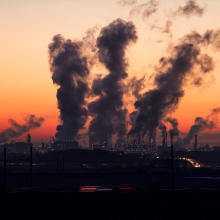
47:08 - Personal pollution sensors
Personal pollution sensors
with Jennifer Quint, London School of Hygiene & Tropical Medicine
With increasing population, inevitably also comes air pollution usually in the form of smog particles and oxides of nitrogen. These have been linked in the  past to respiratory and cardiac problems particularly amongst older people and those with chest diseases. To find out more about who's at risk and why, a team based in London and Cambridge are working together to make personalised wearable sensors that can be given to people with breathing problems to see how pollution exposure affects their symptoms. They're also hoping to use data from the sensors to help people to plot the least polluted routes to work. Jenny Quint is a respiratory physician at the London School of Hygiene and Tropical Medicine, and she explained to Chris Smith
past to respiratory and cardiac problems particularly amongst older people and those with chest diseases. To find out more about who's at risk and why, a team based in London and Cambridge are working together to make personalised wearable sensors that can be given to people with breathing problems to see how pollution exposure affects their symptoms. They're also hoping to use data from the sensors to help people to plot the least polluted routes to work. Jenny Quint is a respiratory physician at the London School of Hygiene and Tropical Medicine, and she explained to Chris Smith
Jennifer - Thanks, Chris. So, for this particular piece of research, we've been interested in looking at the effect of environmental exposures - so temperature and certain pollutants - on people who have COPD which stands chronic obstructive pulmonary disease. Now, this is an umbrella term that covers a spectrum of diseases from chronic bronchitis at one end where people tend to cough, bring up lots of phlegm to those that have emphysema at the other end of the spectrum and predominantly have symptoms of breathlessness.
Chris - In the past people have shown that when the world is having a bad air day, there's a lot of pollution, that the rates of chest problems and also, cardiac problems and strokes shoot up, don't they? So, don't we already know that bad air equals bad chest?
Jenny - That's correct. Work has been done at sort of higher ecological level. In fact, we're just in the process of doing some work at London School of Hygiene and Tropical Medicine at the moment using the national network of monitors to look at temperature and pollution data and to link that with electronic health records. So, hospital episode statistics and GP electronic health records to be able to plot specific patterns that we can see where there are increased hospital admissions or increased GP visits associated with symptoms of COPD at particular times of high air pollution or changes in temperature. But of course, what we don't know is that what goes on at that high ecological level is always what's happening at individual level. And that's the rationale behind taking this work one step further and doing this study and giving patients personal pollution monitors to carry around for 6 months.
Chris - Tell us how this will work then. You give the patient the sensor then what happens?
Jenny - So, the idea is, we will recruit patients who have COPD to carry one of these pollution sensors with them for 6 months and we will ask them to have them with them 24 hours a day to take them when they go out and about. And then in the evening, to set them up on a base station where we'll be able to upload the data that we're obtaining from the monitors. The monitors will be able to record temperature as well as humidity and various pollutants, and particles. And they'll also contain GPS so that we'll be able to look at patterns that people have taken when they've gone out and also a pedometer to be able to look again when they're in and out of the house.
Chris - Can you monitor how active the people are? Obviously, you can see that they're moving. But can you also tell whether they're sitting on a bus and moving or actually, physically walking down the street because that might affect exposure too, might it?
Jenny - Absolutely. So, we know that exposure is affected by temperature, by humidity that changes in wind direction and even the height of buildings alongside the road. So yes, we'll be able to get a little bit of an indication as to how active and out and about people are with these monitors.
Chris - And they're at the same time monitoring their own respiratory function so that you can marry up what the sensors are telling you they've encountered and when and what they were doing, with how bad they think their chest is.
Jenny - Correct. So, we'll do two things. We will give patients say, peak flow monitor to ask them to measure their peak flow on a daily basis to see if we can see any objective change in their lung function. We will also ask them to record symptoms on a diary card so that they can tell us if they're feeling more breathless for example or wheezy on a particular day. On top of that, we will recruit patients through one of the large electronic health records databases, the Clinical Practice Research Data Link and we'll be able to link these patients' electronic health records with the pollution information that they're giving us. So, we'll have two sources of information really - directly from the patient and also from their electronic health record to capture healthcare utilisation.
Chris - What do you think that this is going to enable you to do with respect to our understanding of these sorts of chest diseases that we couldn't do before you were inventing these incredible sensors?
Jenny - So, two things. We know that COPD exacerbations cause an enormous health burden to patients as individuals and also to the healthcare system. So, exacerbations of COPD are the second commonest cause of admission to hospital and the fifth commonest cause of re-admission. So, if there's some way that we can warn patients to perhaps behave in a particularly different way to prevent them from developing symptoms and having an exacerbation, that will benefit them in terms of the natural history of their disease progression. And also, it may allow us to alert hospitals or GPs that there's a particular period of time that's coming up that patients with COPD may be more likely to experience symptoms.
Chris - If equally, a person goes about their daily business, they see that they have - without realising it - come into contact with a lot of pollution that day, could they then take proactive action? They could take some drugs or something for their chest to prevent themselves having a flare up and therefore avoid hospital admission that would otherwise ensue?
Jenny - There aren't any medications that we have that can avoid somebody developing an exacerbation of COPD. But we certainly know that the sooner people start to initiate treatment when they develop symptoms of an exacerbation, the quicker they are to recover from that exacerbation and the less long term damage that has. So, this may be helpful from that standpoint.
Chris - How long before we're generating meaningful data from this because the project is just starting, isn't it?
Jenny - That's right. we're looking to recruit our first patient towards the end of this year, very beginning of next year. I'd like to think we'd have some meaningful output within about 18 months.
Chris - Given that our theme this week is looking at cities of the future, how will this sort of data also inform how people should plan cities and plan the way we live and plan traffic?
Jenny - So, it may well play a role in terms of thinking about where people live relative to the way that they get to work for example or walk to the shops or the vicinity of parks, relative to where people are. I think it'll just make people more aware of what they're exposing themselves to on a daily basis.
Chris - Are you going to roll this out for the general public then?
Jenny - So, once we've looked at this within people with COPD, I think it would be prudent to look within other respiratory diseases such as asthma for example. And potentially yes, this is something that could be rolled out to the wider general public.

Why do leaves turn red in autumn?
Now, we're entering autumn, you may have all noticed the beautiful red and orange colours of the leaves on the trees, but also, the substantial piles of them gathering on the ground. But what exactly causes this to occur? We spoke to Professor Beverly Glover, the director of Cambridge University's botanic gardens who got to the root of this problem...
Beverly - So, we're sitting here in the garden looking at some of the trees changing colour and there's lots of nice oranges and reds. The leaves are changing colour because at this time of year, deciduous trees withdraw the nutrients from their leaves because they're going to drop those leaves off so that they don't waste particularly the proteins, the nitrogen. The leaves is very difficult for trees to get a hold of and they don't want to waste any. Leaves on trees and other plants are usually green because they contain a pigment called chlorophyll and it does the photosynthesis. It gives the plant its energy from the sunlight. So, when they breakdown the green chlorophyll, that reveals the yellow and orange pigments called carotenoids that were there all along anyway. but they're not so easy to breakdown, so they last longer. The reds we see on some of the trees are produced by new pigments that are being made by the trees. These are pigments called anthocyanins. We don't really know why trees make red. Some people think it's to protect the leaves from UV damage. Other people think it's actually a signal to insects to say that these leaves aren't good to eat anymore, and so, don't waste your energy and time coming here. So, the leaves fall off deciduous trees because they can't really do anything useful over the winter. There's not going to be enough light or warmth to photosynthesise. Actually, having a lot of leaves can be quite dangerous if it's very windy. It adds to the surface area of the tree and makes it more vulnerable to losing branches or even being blown over entirely in strong winds. So, this whole process starts off because day length starts to decrease. That sends signals around the plant to start this process of breaking down the chlorophyll and getting the leaves ready to shed. So, people often ask if climate change is likely to affect this process. It won't affect the onset because that's regulated by day length and of course, the reason trees use day lengths to decide when it's winter is that it's the most reliable cue. It doesn't matter what the weather is doing. If the days are getting shorter then winter is coming. So climate change won't affect that, but the degree to which it's warm will affect how quickly the process occurs and how long those lovely colours are around for, and how quickly the leaves are shed.










Comments
Add a comment